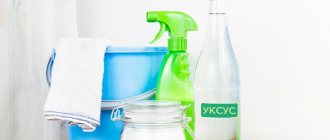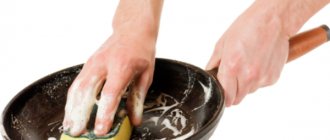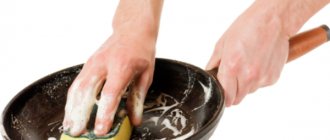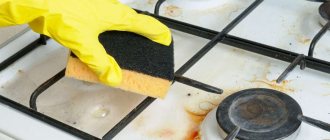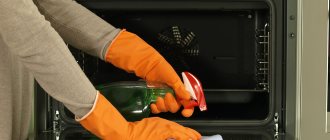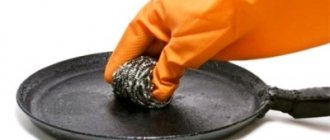However, grease and soot accumulate on the internal surfaces of the cabinet, which can be not so easy to clean. But there are ways that greatly facilitate this difficult procedure.
We will tell you further how to clean an electric oven from carbon deposits and grease.
What are the cleaning methods?
Modern ovens have built-in non-contact cleaning functions, which, based on their operating principle, are divided into:
Catalytic - cleaning during cooking using catalysts (manganese, cobalt, copper, cerium oxide) and absorbents, which are applied to the walls in the form of porous fat-absorbing enamel. Fat and burnt marks, which have turned into water and carbon soot under the influence of high temperature (140–250 ℃) and a catalyst, are wiped off with a dry soft sponge or napkin. There is no enamel on the door and bottom, since milk and sugar often get on these surfaces, destroying the catalytic coating. To clean them, use mild household cleaning products without abrasives. The service life of catalytic cleaning is 5 years.
Pyrolytic – built-in function of cleaning the oven from carbon deposits and grease at a temperature close to 500 ℃. Pyrolysis is the burning of fat deposits to ash. The most aggressive, effective and expensive cleaning method. It requires a lot of electricity, so the equipment is connected using a cable that can withstand loads of up to 6 kW. Carry out such cleaning only after preparing a dish with the hood on.
Hydrolysis – cleaning using water steam and dishwashing detergent. This function is called Cleaning or Aqua clean. Heat the water and cleaning agent inside the oven to the desired temperature. This will soften the fat and drain it into a special tray. This lasts 15–30 minutes. Remove any remaining fat with a napkin. An inexpensive and simple method is not effective for old grease and soot.
Ecoclean is a function for cleaning the oven from grease, the walls of which are covered with a layer of ceramics. At temperatures above 100℃, fat comes into contact with ceramics and breaks down into water and carbon dioxide. Carry out the procedure for 40–50 minutes. Then let the oven cool and wipe with a clean cloth. The cleaning system operates for 10 years.
If there are no built-in cleaning functions, we recommend cleaning the oven from grease and carbon deposits at home using traditional methods. These are the ones that will be discussed in this article.
Combined products of citric acid, soda and vinegar
To make cleaning the oven easier, preheat the oven to 100 degrees. Next you need to do the following:
- to prepare a cleaning solution, mix 100 milliliters of vinegar and 15 grams of citric acid;
- We apply the substance to the working surfaces except heating elements.
The composition should act for 20 minutes, after which we rinse the coating and wipe it with a dry cloth. After carrying out such procedures, open the door for 10-15 minutes for ventilation.
Differences in cleaning gas and electric ovens
Electric and gas ovens have different designs and operating principles.
Clean each of them taking into account these features.
The electric oven is connected to the outlet. If you are not using hot steam cleaning, unplug it before cleaning. In a gas oven, turn off the gas, and if it has electric ignition, remove the plug from the socket.
Do not clean heating elements hidden under the walls of the electric oven. If the heating elements are open, clean them of fat in the same way as the entire oven. Be sure to dry them thoroughly to avoid short circuits when power is applied.
In a gas oven, carefully clean the nozzles located under the removable bottom.
Do not connect the electric oven to the outlet immediately after cleaning and washing to avoid equipment breakdown and wiring failure. First, make sure the inside is completely dry.
Is there a difference in cleaning an oven and a stovetop oven?
The oven and hob are connected to different outlets.
The oven should be switched off before cleaning. And the hob can be used.
In the case of a stove with a built-in oven, unplug the entire stove. You cannot cook on it while cleaning is in progress.
Otherwise, there is no difference between cleaning an oven and a stovetop oven.
Mechanical cleaning
An abrasive kitchen sponge will clean the inside of the oven. This item cleans well any dirt, including grease stains and carbon deposits. A sponge is not used to clean glass doors. After such exposure, scratches may appear on this material, where dirt will subsequently fall.
How to clean the oven - choice of products
All products that will help clean an electric oven can be divided into 3 groups: homemade, household chemicals and special compounds.
When choosing a cleaning method, consider:
- your financial capabilities;
- type, area and freshness of contamination;
- influence of active substances on the health of family members.
For weakly ingrained stains, choose home remedies that any housewife usually has on hand: water, vinegar, salt, soda, ammonia, citric acid, laundry soap. With their help, you can properly wash grease and soot in an electric oven without significant financial costs or harm to health.
Buy household chemicals at the store. Its selection is wide, and the price starts from 30 rubles. It has universal use (washing dishes, tiles, kitchen surfaces) and contains chemically active substances that can break down fat and carbon deposits. To avoid harm to health, use household chemicals according to the instructions and thoroughly wash the surface of household appliances.
Special remedies for burnt fat have a narrow application. These are powders, gels, aerosols designed specifically for electric ovens. Use them on very dirty surfaces and old stains. As a rule, they have a caustic composition (acids, alkalis), a specific odor and a high price.
When cleaning, wear rubber gloves. When working with aggressive substances, use protective clothing, a mask, and goggles.
Fighting old pollution
If the above methods were powerless, it means that your oven has been seriously contaminated, which only the methods listed below or a combination of them can cope with.
Acetic acid (concentrated)
Acetic acid is a very caustic and potent agent, which must be handled using personal protective equipment. Pour 1 liter of water into a deep baking tray with the addition of 2-3 tbsp. with 70% acetic acid. Place the container in an oven preheated to 150°C for 30 minutes. If you manage to steam out the grease stains, you need to remove them with a soap solution and then wash them well with clean water. Never open the oven door while heating, otherwise you may get a thermal burn or inhale hot vinegar fumes.
Salt + acetic acid
The effect of table salt on stains will be stronger if you add a little acetic acid. Dissolve 500 g of table salt in 300 ml of warm water. After cooling, add 1-2 tbsp. spoons of acetic acid. Pour the finished mixture onto a tray and place on the bottom shelf of an oven preheated to 150-200°C. The liquid should boil for 30 minutes. When the oven walls become barely warm, wash them with soapy water.
Mechanical method
The mechanical method consists of combining one of the above methods with the use of a special scraper, which is recommended for smooth glass-ceramic surfaces, but is also excellent for cleaning the oven. A clear advantage over abrasive sponges is the absence of marks and scratches on the surface after applying force. The scraper can also be used to clean the glass door. If the cabinet design allows, remove the glass before using any method. This will greatly simplify the task.
Household chemicals
Well, the most extreme way is to use household chemicals. Surely every housewife has a tool that will definitely help. Of course, folk remedies have clear advantages - they are safer for health due to the absence of strong chemicals. Just imagine what must be in a detergent that can break down even very old fat in a short time. The danger of use also lies in the fact that if there are scratches on the inner surface of the oven, particles of the product may not be completely washed out. And with subsequent heating, vapors of harmful substances will interact with food. That is why cleaning should be carried out at the initial stages of the appearance of contamination, so as not to resort to such radical measures.
How to clean the oven with home remedies
Use home care methods for lightly ingrained drops of grease and carbon stains. If you use them after each cooking, the oven will be like new for a long time.
Fast: steam + dishwashing detergent
Choose this method to clean the oven from fresh grease and traces of soot.
Proceed according to the instructions:
- Remove wire racks, pans and other utensils.
- Place a rimmed baking sheet underneath.
- Pour water into it, without adding 0.5 cm to the edges of the side.
- Add 2-3 teaspoons of dishwashing detergent to the water.
- Close the door and turn on the oven at 150 ℃.
- Heat the water for 30 minutes.
- Leave the oven to cool with the door closed for half an hour.
- Remove and wash the pan.
- Wipe the walls and bottom with a damp cloth and allow them to dry.
If you don’t have a baking sheet, use a wire rack and a stainless steel pan (bowl) placed on it.
Effective: baking soda + vinegar
The method will help clean the electric oven from old carbon deposits and stubborn grease, but it will require physical effort to wipe off the stubborn stains with a sponge.
Follow this sequence of actions:
- Remove dishes, baking sheets, wire racks.
- Make a thick paste from 2-3 tablespoons of baking soda and a small amount of water.
- Using a washcloth, apply the soda mixture to the inside of the walls, paying special attention to problem areas and avoiding getting it on the heating elements.
- Leave the oven for 12 hours with the door closed.
- Afterwards, wipe the surface with a damp cloth or sponge.
- Rub contaminated areas with a stiff brush.
- Spray problem areas with table vinegar using a spray bottle.
- Remove the dirty foam formed in the areas of the reaction of soda and vinegar by wiping with a damp cloth or sponge.
- Spray vinegar on the walls until you can remove stubborn soot and grease.
- Wash the walls thoroughly with clean water.
To work with soda and vinegar, use rubber gloves and a respirator. Open the windows for ventilation.
Safe: water + laundry soap
An environmentally friendly and effective way to remove pollution.
Apply it like this:
- Grate ½ piece of classic laundry soap (72%).
- Dissolve it in a stainless container with 1 liter of hot water.
- Place the vessel with the soap solution on the electric oven rack, from which the dishes and baking sheets have previously been removed.
- Turn the oven on to 200℃.
- After 40 minutes, turn it off and let it cool.
- Wash the inner walls 3-4 times with clean water.
- Place the cabinet door for ventilation.
Wear rubber gloves when working with laundry soap.
Super effective trio: baking soda + laundry soap + vinegar
This method will remove stubborn grease and old carbon deposits from any oven surface.
Do the following:
- Grate ½ piece of regular brown laundry soap.
- Mix 200 ml of 9% table vinegar, 100 gr. baking soda and grated soap.
- Remove baking sheets, wire racks, and kitchen utensils from the oven.
- Wearing rubber gloves, rub the inside surface of the electric oven with the mixture.
- After 2 hours, wash off the grease and soot with clean water.
When working with vinegar, open the kitchen window for ventilation and protect your respiratory tract with a mask.
Simple: ammonia
A caustic substance, which can be purchased at a pharmacy for pennies, will do an excellent job with any fat.
To clean, do the following:
- Remove unnecessary dishes from the electric oven.
- Place a baking tray underneath and fill it with water almost to the brim.
- Heat it to a boil.
- Place a wire rack above the baking sheet and an iron bowl with ammonia on it. 1 bottle will be enough.
- Close the door, turn off the oven and leave it for 12 hours.
- Then remove the bowl with ammonia and the baking tray with water.
- Wipe the walls several times with a rag soaked in clean water.
The aggressive smell of ammonia can cause dizziness, so protect your respiratory system with a respirator and open the window wide during the procedure.
Mixtures of various components
Folk remedies for cleaning the oven involve many combinations of different ingredients. Each is effective in its own way. Let's look at a few of these mixtures, created with our own hands.
Vinegar and soap mixture
This mixture is prepared from one hundred grams of vinegar, diluted laundry soap and baking soda. The walls and door of the oven are covered with the resulting solution. After two hours, remove plaque and grease with a damp sponge .
This option is ideal for cleaning enamel surfaces.
Soda and citric acid
It is recommended to warm up the oven slightly before cleaning. It will take no more than 20 minutes at 50° C. This will help you deal with dirt more easily and effectively. Baking soda is mixed with citric acid and a few drops of vinegar are added. The resulting mixture removes grease, dirt, and carbon deposits well in the oven.
Salt and carbonic acid
These two components will help thoroughly clean the oven, which has accumulated a lot of burnt food. One kilogram of salt is dissolved in half a liter of water, a little carbonic acid is added.
Place the container with the concentrated solution on the bottom shelf of the oven, heat it to 150° C and leave for half an hour. When the oven has cooled, clean it with a cleaning agent and wipe it with a clean cloth.
How to clean an oven with professional products
Household chemicals for electric ovens cope with grease and carbon deposits faster than the best home remedies.
The main active ingredient in them is alkali or acid. Therefore, use them carefully, use protective gloves and clothing, and thoroughly wash the inner walls. If there is a pungent odor, use a respirator and open the kitchen window wide.
Products based on organic components and labeled “ECO” are environmentally friendly and safe for family health.
AMWAY Oven Cleaner Gel
Designed specifically for removing old fat and carbon deposits in an electric oven. Expensive, but effective and economical. Effective within 30 minutes after application. Penetrates deeply into dirt and grime, which can be removed without physical effort with a damp rag or sponge.
To clean the oven, follow this procedure:
- Wear rubber gloves, protective clothing, goggles and a face mask.
- Shake the closed bottle thoroughly.
- Remove racks, baking sheets, and dishes from the oven.
- Using a foam sponge, apply the gel first to the back and sides, then to the ceiling and bottom of the electric oven, paying special attention to old stains and corners.
- Grease the grates and baking sheets with it.
- Let the product work for about 30 minutes.
- Rinse it off 2-3 times with a damp cloth or sponge.
- To prevent the gel from remaining inside and getting into your food, wipe all surfaces with vinegar diluted half and half with water.
The cost of a 500 ml bottle is 450–500 rubles.
Sanita
Available in the form of a gel or spray in a bottle with a sprayer. Thanks to the alkali it contains, it will quickly and effectively clean a heavily soiled electric oven. Easy to use. Does not have a pungent odor.
The order of application is as follows:
- Wear rubber gloves and eye and face protection.
- Remove baking sheets, wire racks, and dishes.
- Shake the closed bottle and open the sprayer.
- Spray the oven interior and utensils.
- Leave it to act for 20 minutes.
- Wash the inside of the oven thoroughly with clean water.
The cost of a 500 gram bottle is 150 rubles.
Top House Cleaner
Suitable for cleaning old grease in microwaves, ovens, stoves. Available in a spray can. Quickly copes with fresh and old stains of soot and grease. Has no smell.
Cleaning procedure:
- Empty the oven of dishes.
- Wear rubber gloves and eye and face protection.
- Shake the can and apply foam to all problem areas.
- Wait 1 hour. For particularly heavy stains, leave the foam on overnight.
- Remove dirty foam from all surfaces with a rag or sponge.
- Wash the oven with clean water and leave it to air.
Do not use the cleaner on aluminum, chrome, imitation stainless steel surfaces or ovens with catalytic cleaning.
The cost of a 300 ml cylinder is 200–250 rubles.
Shumanit Buggy
A quick way to clean an electric oven from old burnt fat in 5 minutes. Available in bottles of 500, 750 or 3000 mg in the form of a cream or spray with a spray. It is easy to use, is used sparingly, disinfects the surface, and is easily washed off with water.
Apply it like this:
- Wear rubber gloves and protective equipment for the face and body (goggles, mask, clothing).
- Open the kitchen window for ventilation.
- Free the electric oven from kitchen utensils.
- Apply Schumanite to the oven walls.
- After 5–15 minutes, remove carbon deposits and grease with a damp cloth or sponge.
- Rinse with clean water 2-3 times and ventilate the oven.
Use Schumanite not only for ovens, but also for surfaces in the kitchen, bathroom, air conditioning units, washing windows, cleaning metal from rust, grease. Do not use the product on aluminum, Teflon, ceramic, or painted surfaces.
The cost of a 500 mg bottle is 500 rubles.
Do self-cleaning ovens need to be washed?
Manufacturers of kitchen appliances care about the convenience and saving time of housewives, so ovens with self-cleaning functions are increasingly appearing on sale:
- catalytic, when a special internal coating prevents the formation of fat deposits during cooking;
- pyrolytic, when the oven must be set to a certain mode so that all the dirt inside turns into ash.
- Owners of such ovens are lucky - the oven itself will do half the “dirty” work for them. All that remains is to wipe the sides, bottom and door with a damp cloth.
- Catalytic enamel usually covers only the walls. The bottom and door need to be washed yourself. An oven without a self-cleaning function will have to be completely washed on its own.
How to clean a glass door
The inside and outside of the glass oven door can be cleaned of dirt and old grease using the previously mentioned home remedies or household chemicals. But the dirt that gets between the glass spoils the whole picture. Solve the problem by disassembling the door.
To start:
- Open the door or remove it if possible.
- Unscrew the inner glass, which is usually secured with several bolts.
- Treat all sides of the glass with a professional cleaner.
- After waiting the right time, remove the dirt with a damp cloth or sponge.
- Rinse thoroughly with clean water.
- Assemble the dry, clean door parts and install it in place.
In this case, you cannot do without male help.
How to clean an electric oven from grease and carbon deposits
The advantage of folk remedies is that they are harmless and do not cause allergic reactions. Of course, it’s easier to clean the oven using an advertised product, but it’s not safe. The fact is that it is impossible to completely remove aggressive substances from surfaces after cleaning, and during the cooking process, toxins and harmful fumes can get into the food. Therefore, it is better to use safer methods.
Cleaning the grates
The oven rack is usually made of stainless steel or cast iron.
Cleaning it is a labor-intensive process that requires attention. Sanita Anti-grease gel will help you cope with the task effectively and quickly:
- Put rubber gloves, a mask and goggles on your face.
- Using a sponge, carefully apply the gel to the grate.
- After 30 minutes, scrub and rinse the grate in the bathroom under the shower.
The grille will be like new.
How to get rid of odor after cleaning
If, after using special products, the chemical smell does not go away from the oven, rinse the walls again with clean water, and then get rid of the unpleasant odor in one of the following ways:
- Heat a glass container with 0.5 liters of water and 2 teaspoons of vanilla extract for 30 minutes at 150℃;
- wipe the inner walls of the oven with table vinegar or vodka;
- Boil a vessel with 3 tablets of activated carbon dissolved in 0.5 liters of water in the oven for 15 minutes.
Additional recommendations
- Apply folk remedies and household chemicals to the cooled surface of the oven.
- Use rubber gloves and personal protection (masks, goggles, clothing) when working with aggressive mixtures.
- For minor stains, try to clean the oven without chemicals; give preference to gentle and health-friendly traditional cleaning methods.
- Clean with open windows or in a ventilated area.
- Use only special products recommended for ovens. Carefully read the precautions and contraindications for their use.
What not to use
- Do not use household chemicals that have expired, so as not to harm your own health and the oven coating.
- Do not scrape off fat and carbon deposits with metal scrapers or brushes, so as not to scratch the inner surface.
- For the same reason, do not use substances with abrasive particles, industrial alkalis and acids.
How to properly care for your oven (prevention of contamination)
To ensure that the oven lasts a long time, follow the basic care recommendations:
- take care of your new oven from the first time you buy it;
- after each cooking, treat the inner surface of fresh fat with dishwashing detergent;
- If used regularly, carry out general cleaning of the oven using traditional methods at least once a month.
To avoid the accumulation of old gunk and the use of harmful household chemicals, regularly apply these simple care rules.
Proper and timely cleaning is the key to a long service life of an electric oven and protecting it from overheating and breakdown. To prevent less fat and soot from accumulating on its walls and to prevent dishes from burning, cover them with a lid, foil or parchment.
What you need
Use rubber gloves with long sleeves and thick rubber. Before work, open a window (window) and use a mask or construction (medical) respirator.
For work you need good rubber gloves, rags, sponges and water
Also, to clean the oven you will need kitchen sponges, rags or porous, highly absorbent napkins/cloths for cleaning. You may need metal scrapers (stainless steel) or hard sponges. A bucket of water that can be changed several times.

